| Article ID | Journal | Published Year | Pages | File Type |
|---|---|---|---|---|
| 443702 | Journal of Molecular Graphics and Modelling | 2007 | 6 Pages |
A reaction path including transition states is generated for the Dowd mechanism [P. Dowd, R. Hershlne, S.W. Ham, S. Naganathan. Vitamin K and energy transduction: a base strength amplification mechanism. Science 269 (2005) 1684–1691] of action for Vitamin K carboxylase (VKC) using quantum chemical methods (B3LYP/6-311G**). VKC, an essential enzyme in mammalian systems, catalyzes the conversion of hydroquinone form of Vitamin K to the epoxide form in the presence of oxygen. An intermediate species of the oxidation of Vitamin K, an alkoxide, acts apparently to abstract the gamma hydrogen from specifically located glutamate residues. We are able to follow the Dowd proposed path to generate this alkoxide species. The geometries of the proposed model intermediates and transition states in the mechanism are energy optimized. We find that the most energetic step in the mechanism is the uni-deprotonation of the hydroquinone – once this occurs, there is only a small barrier of 3.5 kcal/mol for the interaction of oxygen with the carbon to be attacked – and then the reaction proceeds downhill in free energy to form the critical alkoxide species. The results are consistent with the idea that the enzyme probably acts to facilitate the formation of the epoxide by reducing the energy required to deprotonate the hydroquinone form.
